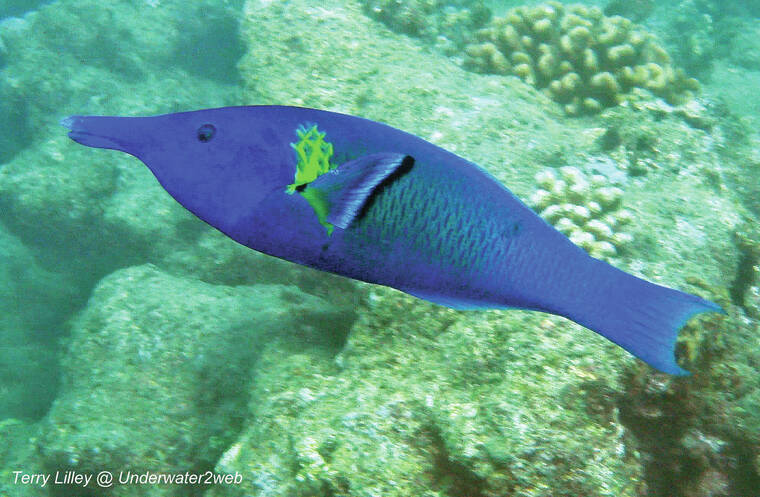Looking out over my dive site the other day right off of the town of Hale‘iwa on the North Shore of O‘ahu, I saw three black iwa birds circling high above. It is fitting that they were flying right above Hale‘iwa, as the town’s name means “house of the iwa Bird.”
The iwa Bird is a type of frigate bird that lives most of its life out at sea. On my scuba dive, I ran into a whole school of bird wrasse that were breeding, which only occurs in the summer when the surf is small.
The Hawaiian name of the bird wrasse is hinalea ‘i‘iwi. Hinalea is the goddess of the coral reef and the ‘i‘iwi bird is the endemic Hawaiian scarlet honeycreeper. It is pretty cool that a town in Hawai‘i is named after a bird and one of the local fish out on the reef is named after a different bird. The Hawaiians knew that every animal in the sea and in the air are related to animals and places on land, and they all share a beautiful connection and names.
Hinalea ‘i‘iwi grows to about a foot long, and the males are normally green and the females are black and white. The males are larger than the females and both sexes have a long curved snout that looks much like the long curved beak of the honeycreeper.
The bird wrasse uses its long snout to eat shrimp and crabs that live deep in the branches of cauliflower coral. Cauliflower coral grows well in the high surf zones along the North Shore, so there are more bird wrasses along the north shore of O‘ahu and Kaua‘i than on the southside.
It is almost impossible to get a picture of hinalea ‘i‘iwi because they never stop moving and they dart around the reef quickly changing directions every few seconds. This way it is hard for big predator fish like ulua to catch them.
The only time I have been successful shooting video of this hyperactive fish is when they are breeding because they forget all about predators for a short while, and you can get very close to them for a change. The male bird wrasse turns from green to bright blue when it is breeding and you usually only see one of them at a time because they are very territorial.
When they breed a group of five or six smaller females will dart upward off of the reef toward the sea surface, and they release their eggs into the water all at the same time. The male follows right behind them and releases sperm, which fertilizes the eggs. This process is call “broadcast spawning.” Once the eggs are fertilized, they drift off in the current and may hatch many miles away from the adults.
Two of the best places to see hinalea ‘i‘iwi up close while spawning are at Sharks Cove on the North Shore of O‘ahu and Tunnels Beach on the North Shore of Kaua‘i. They usually breed more in the late afternoon and at a depth of about 20 to 30 feet. You can see the bird wrasse in action in my movie about the marine life at Sharks Cove on my YouTube Channel at Underwater2web.
•••
Terry Lilley is a marine biologist living in Hanalei Kaua‘i and co-founder of Reef Guardians Hawai‘i, a nonprofit on a mission to provide education and resources to protect the coral reef. To donate to Reef Guardians Hawaii go to www.reefguardianshawaii.org.





